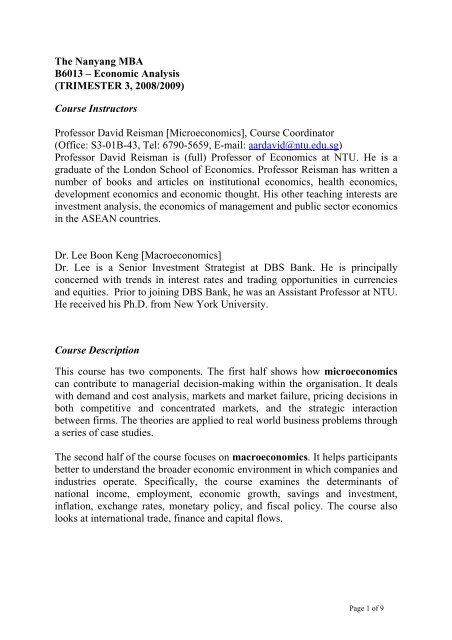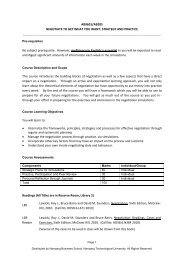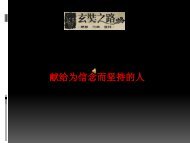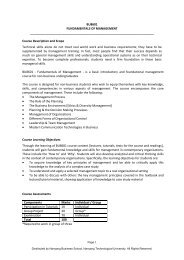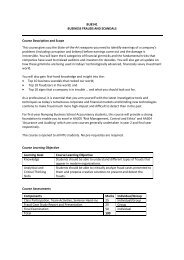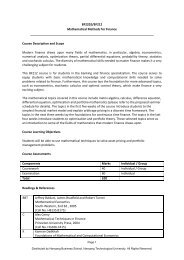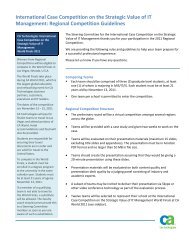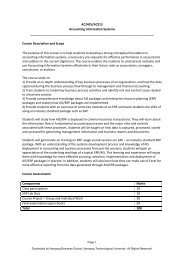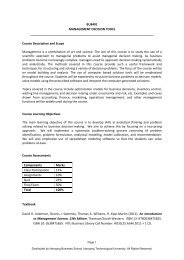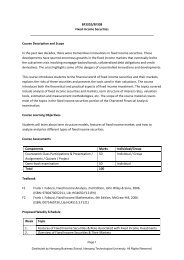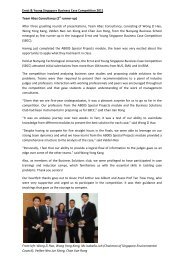The Nanyang MBA - Nanyang Technological University
The Nanyang MBA - Nanyang Technological University
The Nanyang MBA - Nanyang Technological University
Create successful ePaper yourself
Turn your PDF publications into a flip-book with our unique Google optimized e-Paper software.
<strong>The</strong> <strong>Nanyang</strong> <strong>MBA</strong><br />
B6013 – Economic Analysis<br />
(TRIMESTER 3, 2008/2009)<br />
Course Instructors<br />
Professor David Reisman [Microeconomics], Course Coordinator<br />
(Office: S3-01B-43, Tel: 6790-5659, E-mail: aardavid@ntu.edu.sg)<br />
Professor David Reisman is (full) Professor of Economics at NTU. He is a<br />
graduate of the London School of Economics. Professor Reisman has written a<br />
number of books and articles on institutional economics, health economics,<br />
development economics and economic thought. His other teaching interests are<br />
investment analysis, the economics of management and public sector economics<br />
in the ASEAN countries.<br />
Dr. Lee Boon Keng [Macroeconomics]<br />
Dr. Lee is a Senior Investment Strategist at DBS Bank. He is principally<br />
concerned with trends in interest rates and trading opportunities in currencies<br />
and equities. Prior to joining DBS Bank, he was an Assistant Professor at NTU.<br />
He received his Ph.D. from New York <strong>University</strong>.<br />
Course Description<br />
This course has two components. <strong>The</strong> first half shows how microeconomics<br />
can contribute to managerial decision-making within the organisation. It deals<br />
with demand and cost analysis, markets and market failure, pricing decisions in<br />
both competitive and concentrated markets, and the strategic interaction<br />
between firms. <strong>The</strong> theories are applied to real world business problems through<br />
a series of case studies.<br />
<strong>The</strong> second half of the course focuses on macroeconomics. It helps participants<br />
better to understand the broader economic environment in which companies and<br />
industries operate. Specifically, the course examines the determinants of<br />
national income, employment, economic growth, savings and investment,<br />
inflation, exchange rates, monetary policy, and fiscal policy. <strong>The</strong> course also<br />
looks at international trade, finance and capital flows.<br />
Page 1 of 9
Section I: Microeconomics – Weeks 1 through 6:<br />
Professor David Reisman<br />
Prescribed Text<br />
N. Gregory Mankiw, Principles of Economics, 4th Edition, 2007, Thomson<br />
South-Western<br />
Week Topics Readings<br />
1 Introduction<br />
Markets and efficiency<br />
2 Externalities and public goods<br />
<strong>The</strong> cost of production<br />
3 Market structure: competition and<br />
monopoly<br />
4 Market structure: monopolistic<br />
competition and oligopoly<br />
Labour markets<br />
Chapters 1,2, 4, 5<br />
Chapter 6, 7<br />
Chapters 10,11<br />
Chapter 13<br />
Chapters 14, 15<br />
Chapters 16, 17<br />
Chapter 18<br />
5 Case Discussions<br />
6 Case Discussions<br />
Section II: Macroeconomics – Weeks 7 through 12<br />
Dr. Lee Boon Keng<br />
Prescribed Text:<br />
R. Dornbusch and S. Fischer, Macroeconomics, 9 th edn., 2007, McGraw Hill<br />
Week Topics Readings<br />
7 Growth and Inflation Chapters 1,2,6,7<br />
8 Economic Indicators Notes will be<br />
distributed<br />
9 Monetary Policy Chapters 16<br />
10 Monetary Policy Chapter 16<br />
11 Fiscal Policy Chapter 17<br />
Page 2 of 9
12 <strong>The</strong> Open Economy Chapter 20<br />
Assessment<br />
Microeconomics and Macroeconomics each carries a weighting of 50%. Within<br />
each part of the course the marks are distributed as follows:<br />
Class participation/case study 25<br />
Closed book final examination 25<br />
(2½ hours)<br />
Group Presentations for Microeconomics<br />
<strong>The</strong> first four weeks of the module will consist of lectures given by the tutors.<br />
<strong>The</strong> fifth and sixth weeks will be devoted to students’ presentations. <strong>The</strong> cases<br />
to be discussed are included in the course file. During the first meeting students<br />
will form groups and select their seminar topics. Each presentation, which is to<br />
be done in PowerPoint during the last two weeks (weeks 5 and 6), will take<br />
about one hour, including time for discussion and questions. Participants should<br />
hand in to the tutor the final draft of their group’s PowerPoint presentation on<br />
the day of their seminar. Students will receive feedback and be told their mark<br />
by e-mail. None of the cases studied in the course will be the subject of a<br />
question in the final examination.<br />
Seminar Questions for Microeconomics<br />
Every participant is expected to read each of the cases before coming to the<br />
seminar. He or she should be prepared to contribute to the discussion. What<br />
follows are some suggested topics that would make the presentation especially<br />
interesting. Participants should feel free to draw attention to any aspect of the<br />
case that is relevant, even if it is not indicated in the questions below. <strong>The</strong><br />
presentation should draw upon the main concepts of Microeconomic <strong>The</strong>ory,<br />
covered in the lectures and notes.<br />
Week 5/Group 1<br />
Page 3 of 9
Trading the Right to Pollute: Developing a Market for Pollution<br />
Allowances<br />
This case is about a solution to externalities. It is, however, a market solution<br />
rather than a command solution. <strong>The</strong> regulators act through the price<br />
mechanism.<br />
1. What is the problem being addressed? What are the economic issues?<br />
What is the optimum amount of pollution? In what circumstances might<br />
the complete elimination of pollution be economically sub-optimal?<br />
2. For what reasons might an unmanaged market fail to limit noxious<br />
emissions? What policy-tools are at the disposal of government to equate<br />
the private and the social cost? Distinguish in your answer between the<br />
theories of Coase and Pigou. Explain how regulations and prohibitions<br />
might provide an alternative to controls that operate through markets. In<br />
what way does Singapore’s COE policy fit into this framework?<br />
3. What are the viewpoints of different stakeholders? (What would the<br />
different preferences be of a member of Greenpeace, the head of the EPA,<br />
the head of a public utility, the head of the CBT?). Use public choice<br />
theory to explain how pressure groups have an impact upon public policy.<br />
In what way can the public interest be ensured?<br />
4. Are the economic problems of public utilities different from those of<br />
perfect competitors? What are the uncertainties facing natural monopoly?<br />
What criteria could be applied by a regulatory commission? In what<br />
circumstances, if at all, would the problem be solved in the long run by<br />
entrepreneurship and new entry?<br />
Week 5/ Group 2<br />
Duopoly and Uncertainty: <strong>The</strong> Beauregard Textile Company<br />
This case deals primarily with issues of pricing, cost and strategy. Participants<br />
should discuss market share, cost functions (fixed and variable) and alternative<br />
price-volume scenarios. <strong>The</strong> expected value of contribution to profit should be<br />
indicated.<br />
<strong>The</strong> principal questions are:<br />
Page 4 of 9
1. Should Beauregard announce a price of $3.00 or $4.00?<br />
2. How would the numbers be different if Calhoun & Pritchard were to raise<br />
their price to $4.00?<br />
3. Show that the total pie becomes larger if both companies raise their price<br />
to $4.00. Why then might they not do so?<br />
Week 5/Group 3<br />
Antitrust and Competitive Strategy in the 1990s: Microsoft Corp's Pricing<br />
Policies<br />
Provide an overview of government policy to ensure competition in the United<br />
States. Refer to the Sherman Act, the Clayton Act and the Federal Trade<br />
Commission Act.<br />
Provide examples of different types of restrictive practices that are not in the<br />
public interest.<br />
What technical considerations (hardware, software etc.) influence the market for<br />
Microsoft products?<br />
First the group should explain the economic arguments against Microsoft. <strong>The</strong><br />
group should then defend Microsoft’s market position and oppose prosecution<br />
on the grounds of performance. In both opposing and defending, the group<br />
should take into account the relevant statutes and theories of economic<br />
efficiency. Exclusionary licenses, minimum commitments and long contracts<br />
should be cited as possible reasons for thinking that an offence had been<br />
committed. Schumpeter’s arguments for economies of scale and research and<br />
development should be cited in arguing that perhaps large organisations<br />
promote economic welfare.<br />
Apply these concepts to Singapore. What steps have recently been taken to<br />
safeguard adequate competition in Singapore? What lessons does economic<br />
theory teach about the appropriate level of competition in a small open<br />
economy?<br />
Week 6/Group 4<br />
Inputs and derived demand: What Unions Do<br />
Page 5 of 9
1. Explain the unique characteristics of the market for labour. What<br />
monopolistic and monopsonistic elements are present in the wage<br />
bargain?<br />
2. What kinds of allocative and dynamic inefficiency can you detect in the<br />
behaviour of unions? Are there any economic benefits that result from<br />
union activity?<br />
3 Use economic theory to determine the ‘fair’ rate of pay. What role would<br />
you assign to marginal productivity? Average productivity?<br />
Redistribution in line with consensus?<br />
4. Apply the economic theory of unions to the labour market in Singapore.<br />
Show how organisations such as the NWC and the IAC take into account<br />
economic concepts such as supply and demand and the productivity of<br />
labour.<br />
Week 6/Group 5<br />
New entry: Rogers Communications Inc.<br />
1. What is meant by ‘convergence’ of television, telephone and computing.<br />
How does it affect the future of cable television? How does it affect<br />
Rogers?<br />
2. Consider this convergence from the perspective of the consumer. How<br />
will convergence deliver benefits to consumers? How rapidly are<br />
consumers likely to embrace these benefits? What impediments exist to<br />
their adoption?<br />
3. What is your assessment of Rogers’ new product development process<br />
with respect to high speed web access?<br />
4. What is the likely size of the market for high speed Web access in the<br />
Newmarket suburb of Toronto over the next three years? On what factors<br />
does your estimate depend?<br />
5. How should Rogers design its launch offering the WAVE?<br />
Page 6 of 9
Week 6/Group 6<br />
Modeling and games: Judo Economics<br />
This case is about small-scale entry into a market.<br />
1. Suppose that:<br />
a. Each buyer has a willingness-to-pay of $200 for one unit of either<br />
the incumbent’s or entrant’s product.<br />
b. Both incumbent and entrant have a $100 unit cost of serving<br />
buyers.<br />
Formulate a strategy for the entrant. How much money can the entrant<br />
make?<br />
2. Now suppose that:<br />
a. Each buyer has a willingness-to-pay of $200 for one unit of the<br />
incumbent’s product and $160 for one unit of the entrant’s product.<br />
b. <strong>The</strong> incumbent has a $100 unit cost and entrant has a $120 unit<br />
cost of serving buyers.<br />
Formulate a new strategy for the entrant. How much money can the<br />
entrant make?<br />
3. Finally suppose that:<br />
a. Each buyer has a willingness-to-pay of $200 for one unit of either<br />
the incumbent’s or entrant’s product.<br />
b. <strong>The</strong> incumbent has a $120 unit cost and entrant has an $80 unit<br />
cost of serving buyers.<br />
Formulate a new strategy for the entrant. How much money can the<br />
entrant make?<br />
4. How much value does the entrant add in each of the games described in<br />
1, 2 and 3 above? How does the amount of value that the entrant adds in<br />
each game compare with the amount of money it can make in the game?<br />
<strong>The</strong> incumbent basically has two strategies. It can accommodate entry or fight<br />
entry. Participants need to evaluate both these and the entrant’s post entry<br />
decision problem. Give real world examples of cases where a small firm might<br />
have employed ‘Judo’ strategies to enter a market.<br />
Each game can be represented diagrammatically with $s on the vertical axis and<br />
the number of units on the horizontal axis. Value can be shown as a rectangle<br />
(the total pie). It then is easy to show who captures how much of the value.<br />
Page 7 of 9
As this case is rather brief, detailed notes are provided to accompany it. <strong>The</strong><br />
notes will assist the student but they are not a full answer to the question.<br />
Coursework for Macroeconomics<br />
Participants will receive a coursework mark-based on class participation and<br />
individual projects. Topics and further information about assessment will be<br />
distributed at the first meeting of the Macroeconomics module.<br />
Page 8 of 9
Page 9 of 9


